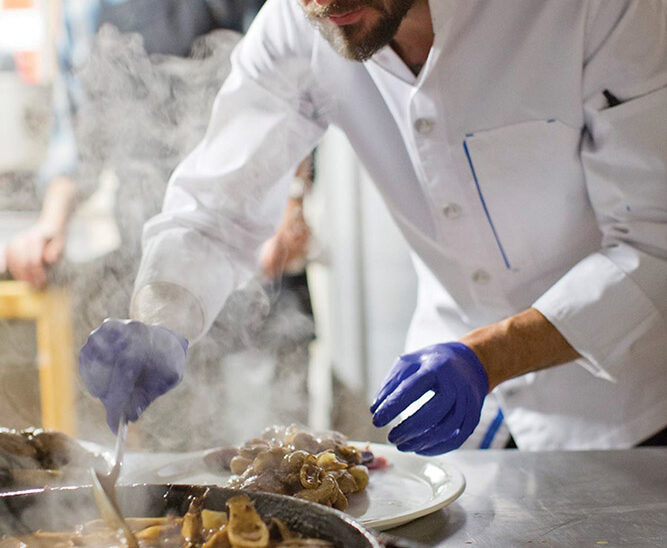Restaurant Industry's Back-of-House Going to Pot
Colorado hospitality industry losing workers to lucrative marijuana industry
Jamie Siebrase //September 28, 2017//


Restaurant Industry's Back-of-House Going to Pot
Colorado hospitality industry losing workers to lucrative marijuana industry
Jamie Siebrase //September 28, 2017//

In Denver’s booming restaurant scene, there are plenty of customers to fill the seats out front. The problem: finding workers to staff the kitchens and clear the tables in the 200-plus eateries opening their doors every year.
And it doesn’t help that another explosive local industry draws from the same pool of potential employees.
“Colorado’s restaurant labor market is in Defcon 5 right now, because of weed facilities,” says Bobby Stuckey, the James Beard award-winning co-owner of Frasca Food & Wine in Boulder. “No one is talking about it.”
Brava! Pizzeria owner Thomas Garnick, who employs about 20 food workers, says several have moonlighted at cultivation facilities and dispensaries during their tenure at Brava! A few left the pizza shop altogether after accepting full-time positions in the marijuana industry.
“It is a real thing,” says Bryan Dayton, co-owner of three popular spots, Oak at Fourteenth, Acorn and Brider. “We had a chef leave a couple of weeks ago to work at a grow house.”
It’s impossible, though, to fully grasp the extent of the problem. As Carolyn Livingston, communication director at the Colorado Restaurant Association points out, “Nobody is tracking how many kitchen workers leave restaurants for jobs in the pot industry. Why do people leave most jobs? It’s money or it’s labor conditions,” she says.
READ MORE: HOW DENVER RESTAURANTS AND RETAIL ADAPT TO RISING RENTS
In this particular instance, both elements are probably at play. In Denver, entry-level restaurant workers might make up to $14 an hour — compared with $20 to $25 an hour in most local cultivation facilities. Livingston notes that $14 an hour isn’t too shabby for a dishwasher. “The pay disparity between front-of-house and heart-of-house is a huge issue,” she adds — but that’s a whole other story tangled up in state minimum wage law.
While cash is king, it isn’t the only leverage. In a restaurant, Dayton says, “You’re on your feet for eight to 10 hours running around, and the work is demanding, both physically and mentally.” As Garnick says, “Restaurants are fast-paced, high-intensity environments, and our industry can be a thankless one.”
Parks McMillan, director of cultivation at Seed and Smith, a Stapleton-based startup cultivation facility for medical and recreational marijuana, says it’s a common misconception that cultivators are “sitting in the back, smoking joints and listening to reggae.
“My guys work pretty hard,” McMillan says, although he admits the work is more laid-back than your average open-window restaurant kitchen.
As far as Michael Leibowitz knows, none of his 50 or so employees came from the restaurant business, but the Denver-based owner of Veritas Fine Cannabis can see why workers – all workers – are drawn to his line of work. “Certainly, there is a smaller pool of qualified workers in the labor force in general because of our industry,” he says.
Employees don’t need much experience to snag jobs in cultivation facilities, where they’ll cut their teeth washing pots and trimming plants. Leibowitz starts qualified grow cultivators at $20 an hour, and he’s looking into offering his employees health insurance, which is a trend across the industry. In contrast, “The restaurant industry is a low-margin one, and most of us restaurant owners don’t have the luxury of being able to offer health insurance to all of our employees,” Garnick says.
“Restaurants operate on razor-thin profit margins, like 3 to 6 percent,” says Livingston, who isn’t convinced that weed is the problem.
Neither is Stuckey. “The marijuana industry is one piece of it,” he says.
His theory?
"You’re dealing with a state that has very low unemployment rates. I think it’s great that I live in a market that’s over-employed, but it makes for a competitive job market.”
In Colorado, about 18,000 people have jobs in the marijuana industry, which generated $1.1 billion in profit in 2016. Restaurants, on the other hand, employ 275,000 workers statewide – 12 percent of Colorado’s work force – and the industry expects to reach $12 billion in food and drink sales this year. As the restaurant industry expands, Livingston says, “What restaurant owners are really struggling with is losing workers to other restaurants.”
Stuckey has a slightly different take.“One thing I think most people don’t realize is that the restaurant industry competes with all other industries — with one arm tied behind its back.”


























